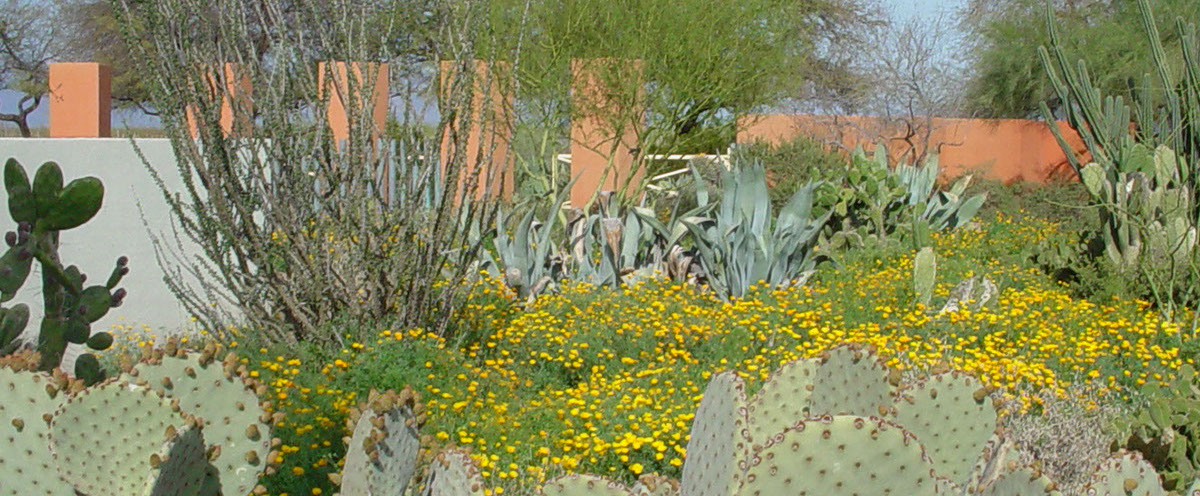
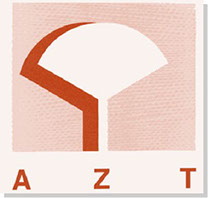

Single Leader versus Multiple Trunk Desert Trees
It is all too common for horticultural professionals, including wholesale tree growers, to ignore the natural growth characteristics of desert adapted trees when pruning and shaping these unique trees. Trees native to mixed conifer and hardwood forests have a generally upright growth habit, typically dominated by a strong central leader. In their native forests, competition is primarily for light. The ability to grow straight and tall give these trees a significant competitive advantage over trees with other growth habits. On flood plains or in riparian areas, increased soil moisture affords trees the luxury of not having to conserve water resulting in faster, more vigorous growth and often more columnar form. With the availability of water and nutrients no longer limiting factors, competition for space and sunlight become more intense. This situation results in taller, more upright trees growing closer together. Resistance to wind remains high since individual trees function as windbreaks for their neighbors.
In their native habitats, most desert trees species branch at or just above ground level. While they may begin their lives as single leader seedlings, vegetative buds at the leaf nodes are soon stimulated and multiple branching results. This is particularly true of arid (xeric) sites where trees such as Velvet Mesquite (Prosopis velutina) and Catclaw Acacia (Acacia greggii) often form dense hemispheres of branches covering the ground around the tree bases. In the southwestern deserts competition is primarily for water. In this habitat trees are typically highly dispersed and tend to grow nearly as wide as they are tall, producing branches that often extend to the ground. This low branching helps to conserve moisture within the drip-line by shading the ground from the direct rays of the sun. It also diverts winds around and over the leaf canopy, instead of through it. The shade produced also inhibits the germination of other seeds close to the base of the tree which reduces competition for moisture and nutrients. This unique growth habit must be considered when developing pruning practices for desert region trees in landscape applications. The goals of pruning desert trees must be to promote tree vigor and health and to enhance and compliment the natural form of these native species. For pruning information please visit www.aridzonetrees.com FAQ “Pruning Desert Trees”.
In landscape settings, created in the course of construction and land development, a third type of environment is found. In these situations, neither water nor space is limiting factors, so that desert trees can grow rapidly in both directions. This growth can cause problems in areas where people and vehicles need to pass, such as along sidewalks and paths or in parking lots. Pruning is used to control and direct the growth of woody plants, particularly trees. Unfortunately, in many instances, tree structure and balance are destroyed in the process. For example, many multiple trunk thornless mesquites have been pruned to a single, crooked trunk in the mistaken belief that the tree width can be reduced. Most properly pruned and shaped, multiple trunk trees take up no more horizontal space than do single trunk trees. The trunks (3, 5, or 7, in most cases) can be selectively pruned to establish the lowest main laterals or scaffold branches at the height desired. Gradually branches can then be "laced out" or thinned. With the thinning of the lower branches wind is diverted around and over the tree allowing the wind to pass more easily through and around the tree.
The recent introduction of cloned or vegetatively propagated varieties of desert species has made the task of pruning and shaping trees for increased pedestrian access easier. Trees being considered for cloning must first be evaluated for upright structure, proper branch angles, response to pruning and other physical and horticultural qualities before being considered as potential “Mother” stock. With cloned trees, high notable genetic uniformity, consistent and predictable growth habits and growth rates make the process of fostering desirable tree forms straightforward. Such trees respond to pruning in a reliable and predictable way making long term maintenance, to retain and encourage this form, simpler and ultimately more successful.
Growers of desert tree species typically produce both single (a) leader and true multiple trunk trees (trees which product multiple vertical branches at or near the soil level) as well as "low-breaking multiple trunk" (trees which branch from 6” to 24"). A higher percentage of singles are produced by most growers than exist in Nature. This tendency can be attributed to the following: 1) Convenience--it is often easiest for a nursery worker to select the largest stem and tightly stake it up, thus avoiding having to make critical pruning decisions required to produce attractive multiple trunk trees; 2) Convention--a client's preconceived notion of what a tree "should" look like often incorporates the straight-trunk, rounded head "lollipop" effect; and 3) Confusion--the incorrect assumption that a single leader trunk tree takes up significantly less space than a multiple and that multiple trunk trees interfere with pedestrian and vehicle traffic. As a result, singles are often specified for use in parking lots, street plantings and pedestrian paths, when the selection of cloned multiple trunks with vertical growth are equally appropriate.
There are situations in the landscape where even narrow multiple trunk trees would not be appropriate (e.g. a three to four foot wide planting strip between a sidewalk and a wall). In such instances it would make sense to select desert tree species with a vertical rather than a spreading habit. Choices include Palo Blanco (Acacia willardiana), Shoestring Acacia (A. stenophylla), Coonavitra Wattle (A. jennerae) and Mulga (A. aneura). Such trees would function better than species with crowns that would be crowded by the wall or pedestrian access.
The use of multiple trunk desert trees in the landscape should be encouraged in all facets of the landscape industry, from design to construction to retail sales. The natural grace and beauty multiple trunk trees bring to the urban landscape are important factors in the health, aesthetics and durability of desert landscapes. Tree form or structure also plays a role in wind throw. Retaining this attractive, more natural, multiple trunk form provides easy pedestrian access, offers ample shade, essential structural support and lowers the risk of wind throw without compromising the other uses of the landscape. Wind throw is not inherently a horticultural problem unique to desert tree species like Thornless Mesquites. Proper planting, pruning, tree form and placement, irrigation and fertilization are all keys to vigorous long lived trees.
(a) The definition “Standard” found in Hortis Third (MacMillian Publishing Company, New York) more accurately describes small statute, patio-type trees (with 3 to 6' of clear straight trunk) like tree roses, tree Fuchsias and Azaleas than it does the vast majority of desert adapted tree species. AZT uses single leader trunk to better create a distinction image between single trunk, low breaking multi trunk, and true multiple trunk specimens.
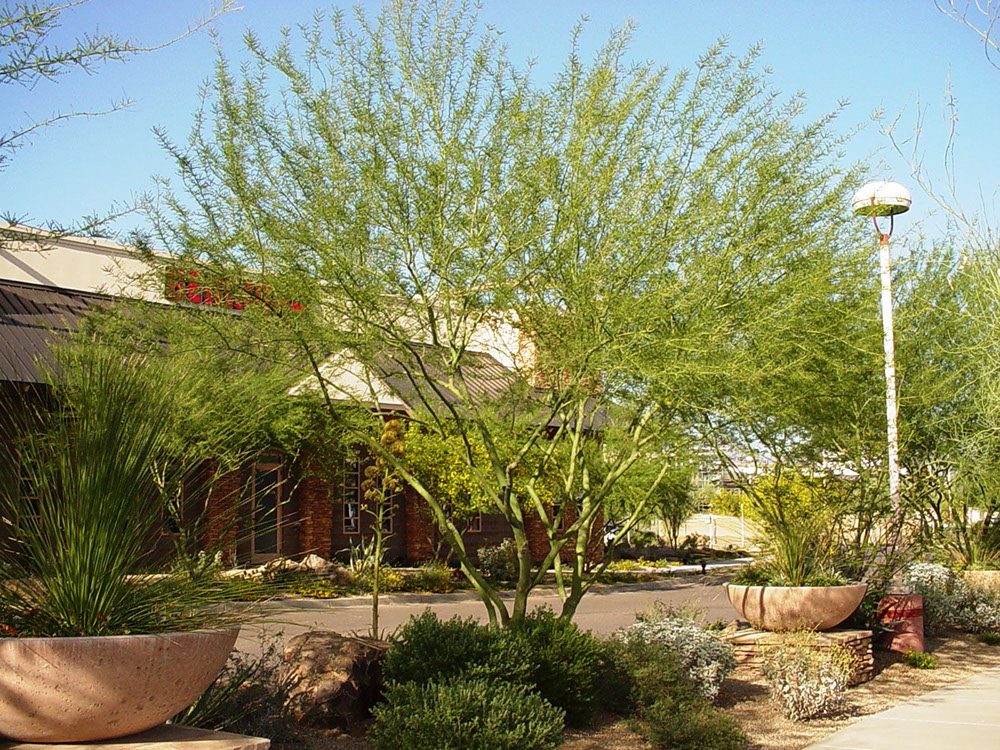
Cercidium (Parkinsonia) hybrid 'Desert Museum'
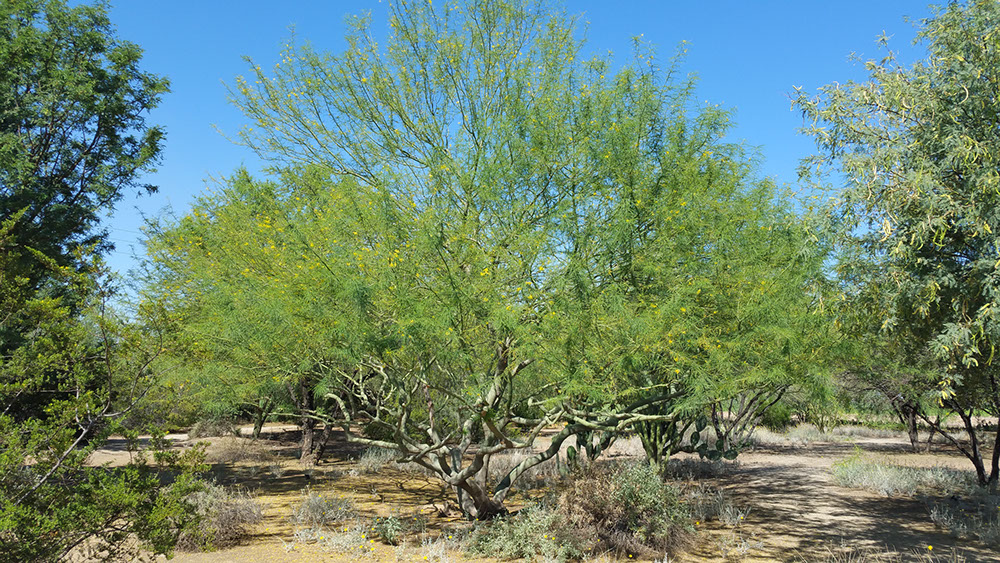
Cercidium (Parkinsonia) thornless hybrid 'AZT'
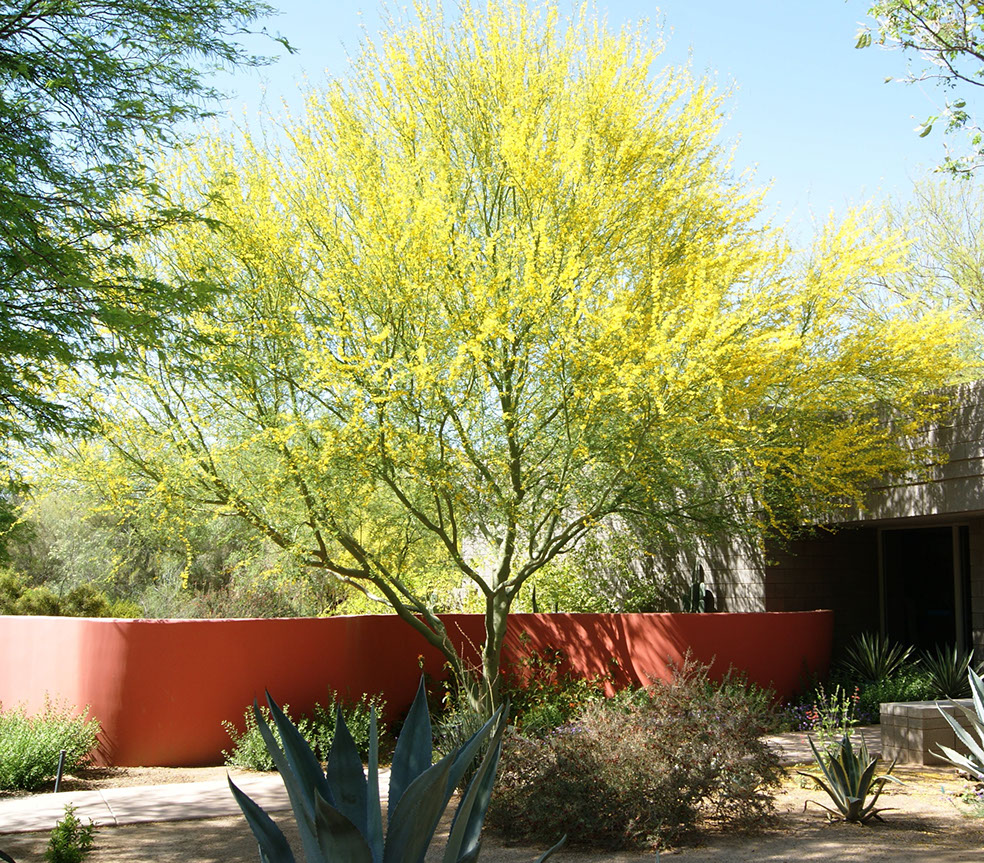
Cercidium (Parkinsonia) praecox 'AZT'
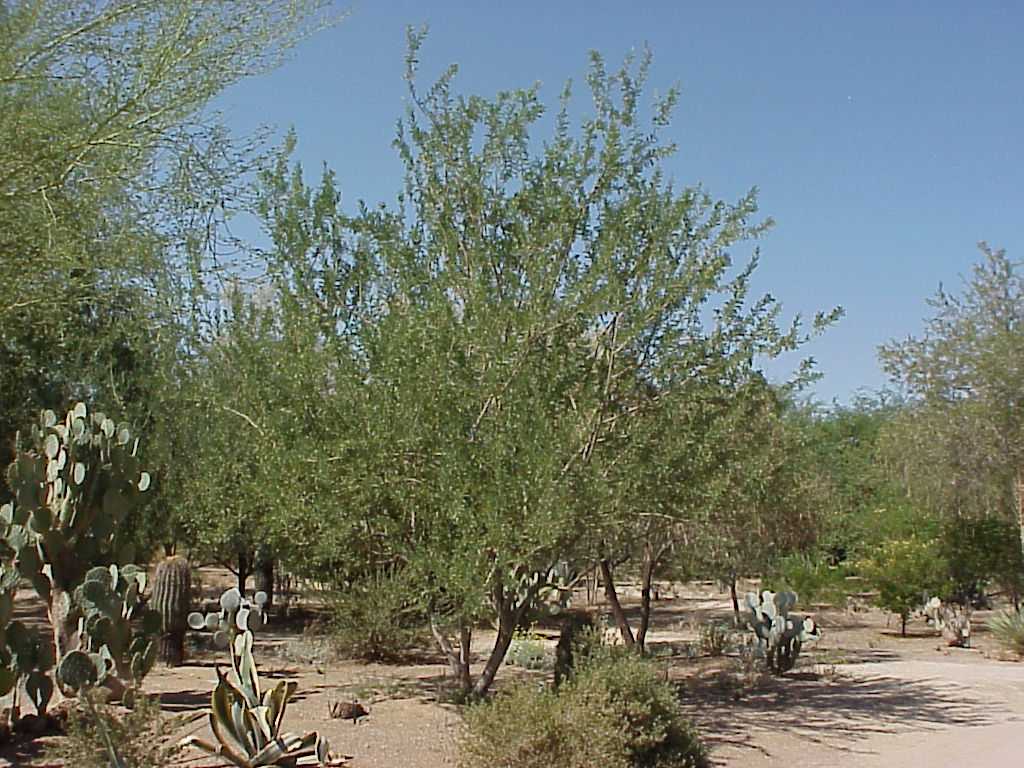
Olneya tesota 'AZT'
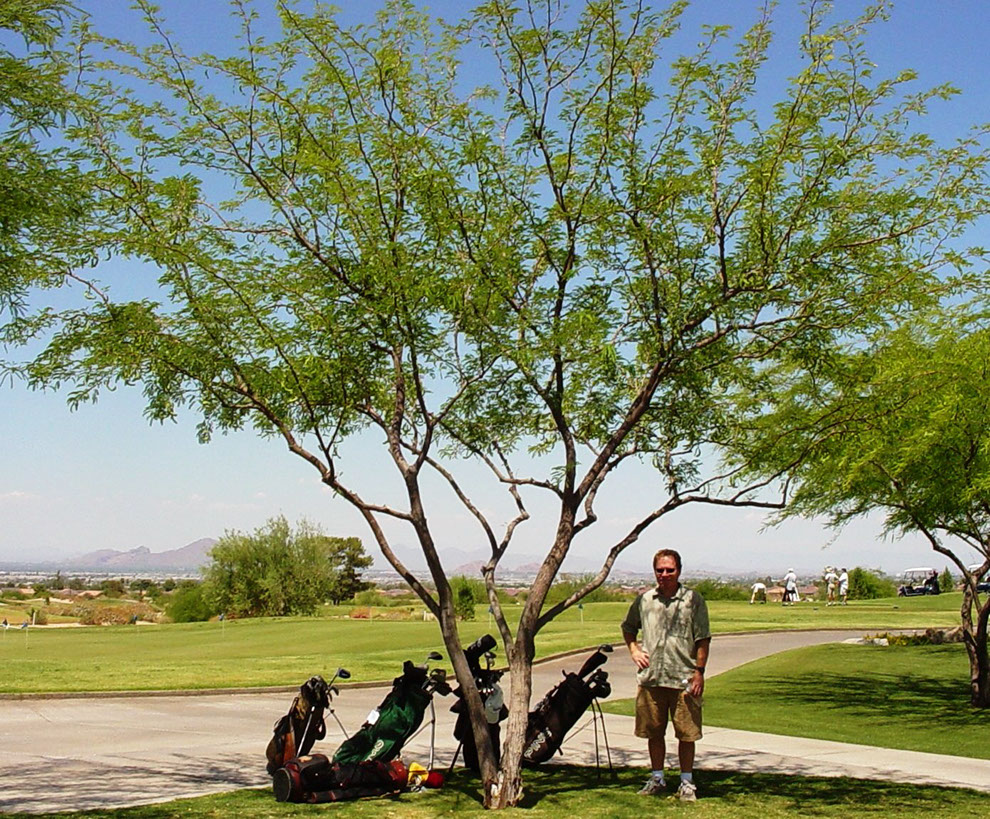
Prosopis thornless hybrid 'AZT'
Landscape trees are used to provide shade, privacy, security, create scale, temper the harsh visual and physical effects of buildings and hardscape elements and interact with vehicular and pedestrian traffic. In some landscape settings they are called upon to do all these at once. Some landscape architects, often with the encouragement or prompting of municipal landscape review staff, will specify standard or single trunk trees along pedestrian paths, parking lots or street frontages thinking that multiple trunk and low branching specimens will interfere with foot and car traffic. Properly selected and shaped, low-branching, upright trees occupy no more space in the landscape then do single-trunk specimens. Retaining this attractive, more natural, multiple trunk form provides easy pedestrian access, offers ample shade, essential structural support and lowers the risk of wind throw without compromising the other uses of the landscape.

© Copyright 2000-2020 Arid Zone Trees